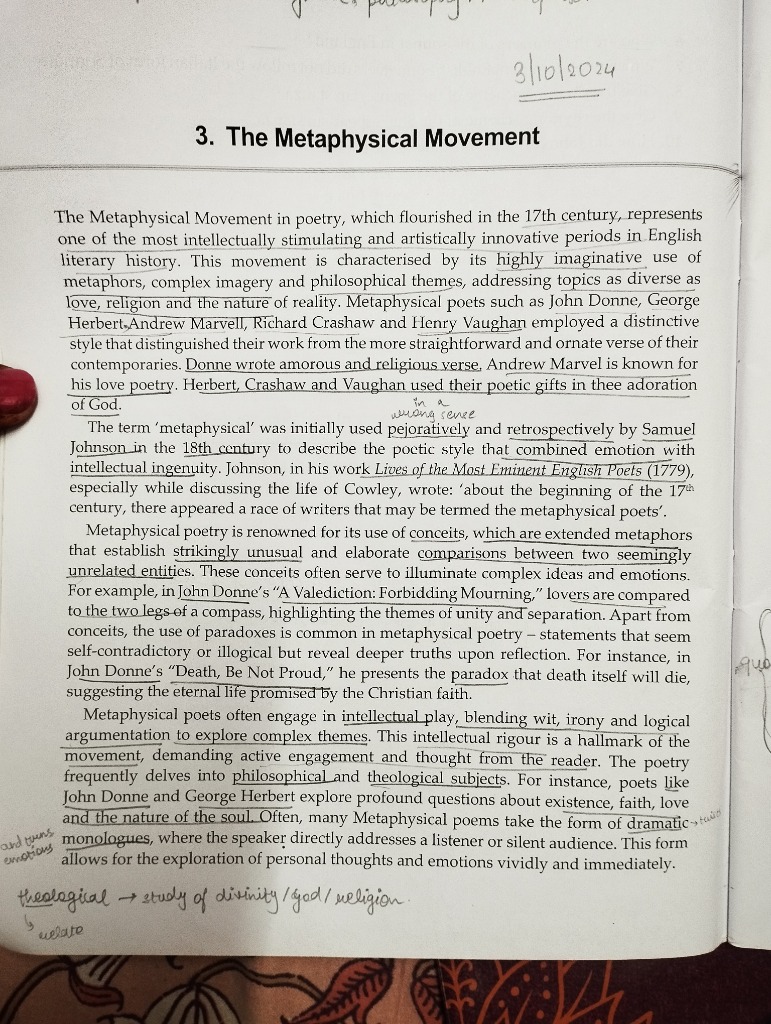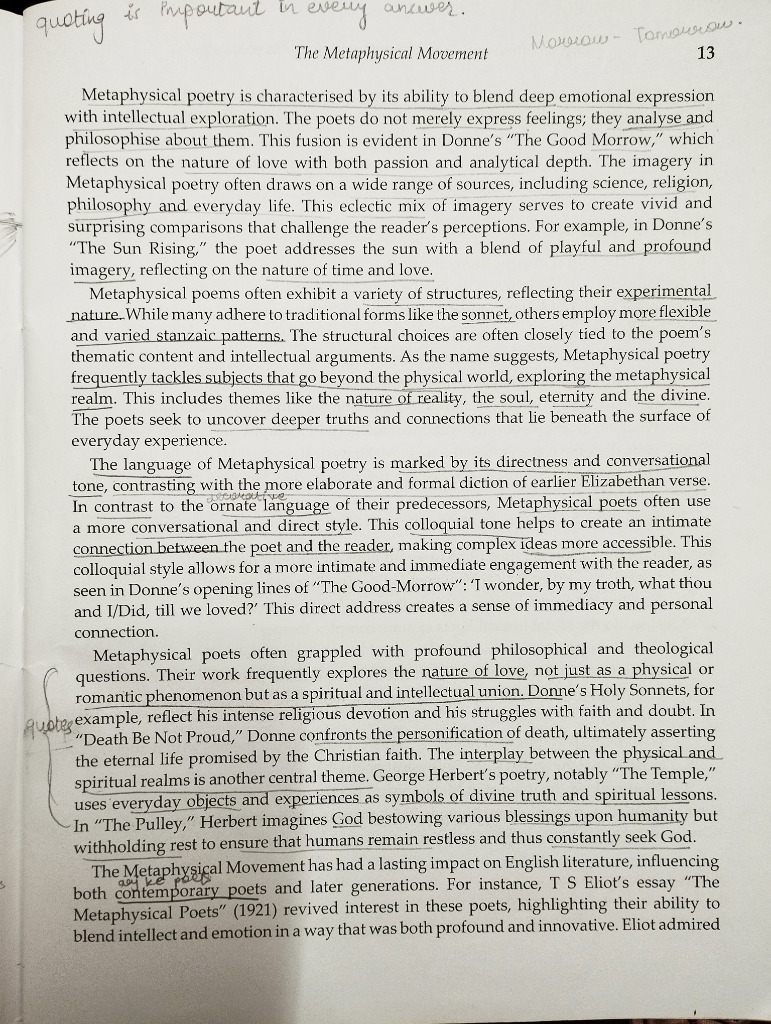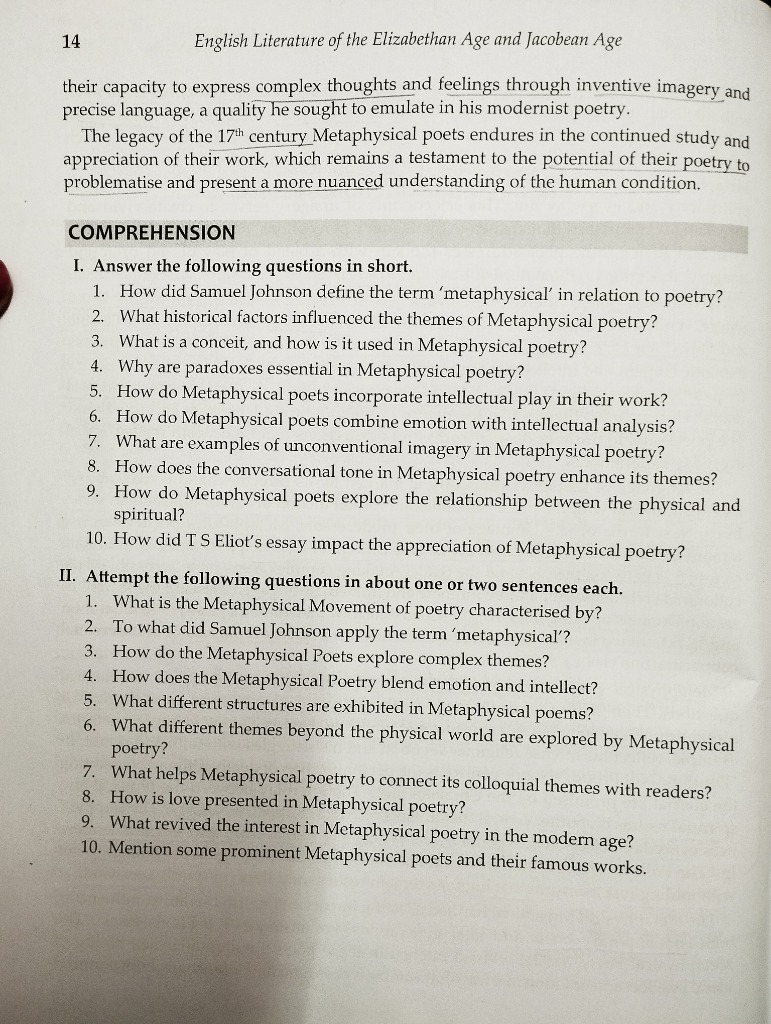The Metaphysical Movement in Poetry: An Overview
The Metaphysical Movement

Overview
-
Period and Importance:
- Flourished in the 17th century.
- Known as an intellectually stimulating and artistically innovative period in English literary history.
-
Characteristics:
- Metaphors: Highly imaginative use.
- Imagery: Complex and vivid.
- Themes: Philosophical, addressing love, religion, and the nature of reality.
Key Poets
- John Donne: Known for amorous and religious verse.
- George Herbert, Andrew Marvell, Richard Crashaw, Henry Vaughan: Noted for their distinctive style.
- Marvell: Famous for love poetry.
- Herbert, Crashaw, Vaughan: Used poetic talents in the adoration of God.
- Style:
- Combines straightforward and ornate elements.
Terminology
- Metaphysical:
- Initially used pejoratively by Samuel Johnson in the 18th century.
- Describes a poetic style blending emotion with intellectual ingenuity.
Literary Devices
-
Conceits: Extended metaphors making comparisons between unrelated entities.
- Example: Donne’s “A Valediction: Forbidding Mourning” compares lovers to legs of a compass.
- Highlights themes of unity and separation.
-
Paradox: Highlights contradictions that reveal deeper truths.
- Example: Donne’s “Death, Be Not Proud” suggests the paradox of eternal life in Christian belief.
Intellectual Engagement
- Complex Themes: Blending wit, irony, and logical argumentation.
- Reader's Engagement: Demands active thought and engagement.
- Exploration of Philosophical and Theological Subjects:
- Questions about existence, faith, love, and the nature of the soul.
- Dramatic Monologues:
- Direct address from the speaker to an audience.
- Explores personal thoughts and emotions vividly.
Additional Insights
- Samuel Johnson's Perspective:
- Critique was retrospective and rhetorical.
- Intellectual Rigor:
- A hallmark of the movement, requiring deep engagement with content.
Conclusion
The Metaphysical Movement pushed the boundaries of poetic expression, blending deep intellectual inquiry with emotional exploration, thus creating a rich tapestry of literature that continues to be studied and appreciated.
Extended readings:
The Metaphysical Movement

Characteristics of Metaphysical Poetry
-
Blend of Emotion and Intellect: Metaphysical poetry combines deep emotional expression with intellectual exploration.
- Insight: This fusion allows for a more nuanced and philosophical take on themes like love and faith.
-
Imagery and Themes: Imagery in metaphysical poetry is eclectic, drawing on science, religion, philosophy, and everyday life.
- Example: Donne’s “The Good Morrow” reflects on love with both passion and intellectual depth.
-
Unique Structural Choices: Metaphysical poems often exhibit a variety of structures, from traditional sonnets to more flexible forms and varied stanzaic patterns.
- Insight: These structures support the thematic content and intellectual arguments of the poems.
-
Exploration of Profound Themes: Themes often include the nature of reality, the soul, eternity, and the divine realm.
- Insight: This exploration helps uncover deeper truths beneath everyday experiences.
Language and Style
-
Direct and Conversational Tone: Marked by a straightforward and direct style, metaphysical poetry tends to differ from the more elaborate language of earlier Elizabethan poetry.
- Insight: This colloquial style fosters a sense of intimacy and immediacy between the poet and the reader.
-
Connection with the Reader:
- Example: Donne’s direct address in "The Good-Morrow" creates a personal connection, enhancing engagement.
Common Themes
-
Philosophical and Theological Questions: Frequently explores the nature of love as both a physical and spiritual union.
- Example: Donne’s Holy Sonnets reflect themes of faith, doubt, and the confrontation with death.
-
Interplay of Physical and Spiritual Realms: Uses everyday objects to convey divine truths and spiritual lessons.
- Example: George Herbert's "The Temple" uses this interplay effectively.
Lasting Impact
- Influence on English Literature: The metaphysical movement has significantly impacted both contemporary and later poets.
- Example: T. S. Eliot’s essay “The Metaphysical Poets” revitalizes interest in the blend of intellect and emotion characteristic of this movement.
These insights and examples help deepen understanding of the metaphysical movement in poetry, highlighting its lasting influence and intellectual depth.
Extended readings:
English Literature of the Elizabethan Age and Jacobean Age

Comprehension
I. Responde brevemente a las siguientes preguntas
-
Definición de 'metafísico' por Samuel Johnson:
- Johnson definió 'metafísico' en poesía como una fusión de ingenio y profundidad filosófica.
- Los poetas metafísicos exploran temas complejos a través de imágenes inventivas.
-
Factores históricos que influyeron en los temas de la poesía metafísica:
- La agitación social y la exploración científica del siglo XVII influyeron profundamente en los temas.
- La poesía refleja conflictos religiosos y avances en el conocimiento.
-
Conceit y su uso en la poesía metafísica:
- Un conceit es una metáfora extendida que vincula dos ideas aparentemente no relacionadas.
- Proporciona un enfoque único e ingenioso a temas complejos.
-
Importancia de las paradojas:
- Las paradojas resaltan las contradicciones en la condición humana.
- Permiten explorar diferentes capas de significado.
-
Juego intelectual en el trabajo metafísico:
- Incorporan humor y agudeza para engendrar un pensamiento más profundo.
- Ejemplos incluyen juegos de palabras y razonamientos inesperados.
-
Combinación de emoción y análisis intelectual:
- La poesía metafísica busca un equilibrio entre sentimientos intensos y razonamiento crítico.
- El tono discursivo y la pasión emocional se entrelazan.
-
Ejemplos de lenguaje de imágenes no convencional:
- Las imágenes suelen ser abstractas y sorprendentes.
- Influyen en la percepción del lector sobre lo cotidiano.
-
Uso del tono conversacional:
- Fomenta una conexión más directa y personal con el lector.
- Mejora el impacto emocional y temático del poema.
-
Exploración de lo físico y espiritual:
- La poesía metafísica busca unir la experiencia terrenal con ideas espirituales y filosóficas.
- Destacan las dualidades de la existencia humana.
-
Impacto del ensayo de T.S. Eliot:
- Eliot reafirmó la importancia de la poesía metafísica en el canon literario.
- Su ensayo ayudó a revivir el interés por estos poetas en la era moderna.
II. Responde las siguientes preguntas en uno o dos oraciones
-
Características del Movimiento Metafísico de poesía:
- Se caracteriza por su ingenio, imágenes sorprendentemente vívidas y una fuerte inclinación filosófica.
-
Aplicación del término 'metafísico' por Samuel Johnson:
- Lo aplicó para describir a poetas que combinaban la emoción con análisis intelectual.
-
Exploración de temas complejos por poetas metafísicos:
- Utilizan comparaciones inesperadas y paradojas para abordar temas difíciles y multifacéticos.
-
Mezcla de emoción e intelecto en la poesía metafísica:
- Concilian la emoción con el razonamiento lógico para brindar una experiencia poética profunda.
-
Estructuras exhibidas en poemas metafísicos:
- Presentan estructuras libres y rítmicas mezcladas, a menudo rompiendo moldes tradicionales.
-
Temas más allá del mundo físico:
- Exploran cuestiones espirituales, filosóficas y existenciales.
-
Conexión con lectores a través de temas coloquiales:
- Usan lenguaje cotidiano para acceder a las emociones y experiencias comunes del lector.
-
Presentación del amor en poesía metafísica:
- El amor se presenta de manera compleja, a menudo analizado y diseccionado filosóficamente.
-
Revival del interés moderno en la poesía metafísica:
- Fue revivido por críticos como T.S. Eliot que resaltaron su valor literario.
-
Poetas metafísicos prominentes y sus obras:
- Poetas como John Donne y George Herbert con obras como "The Flea" y "Easter Wings" respectivamente.
Lecturas extendidas: